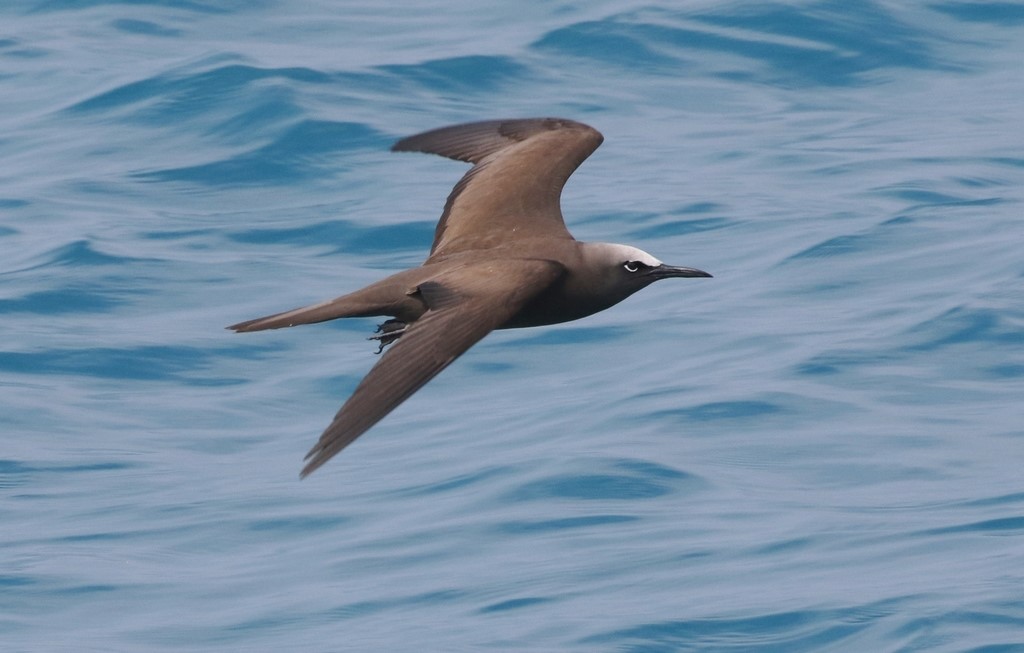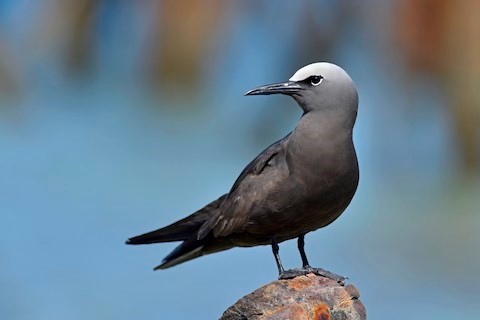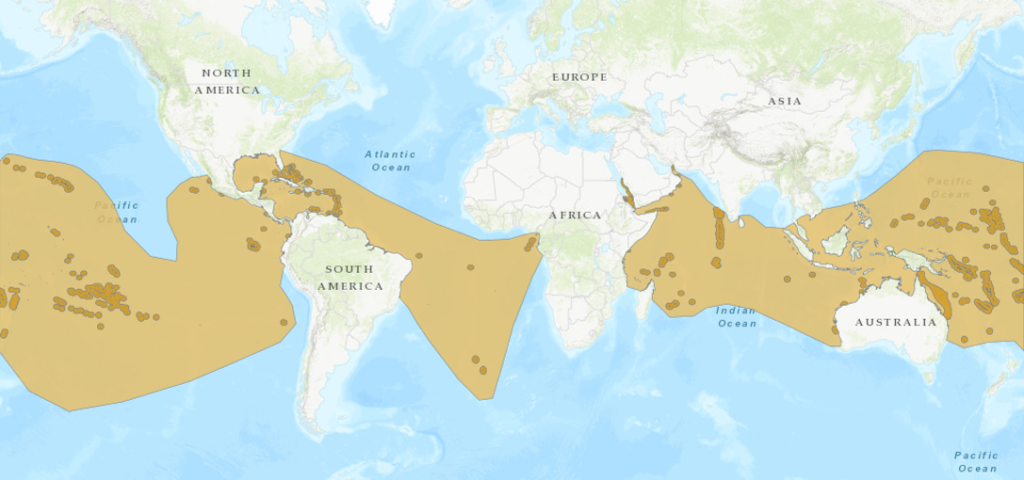Birdfinding.info ⇒ Among the commonest and most widespread of seabirds globally, present at least in small numbers nearly throughout the tropical seas—but generally rare along most continental coasts. In the U.S. there is a colony of about 2,000 pairs on Bush Key in Dry Tortugas National Park, where it is present from January to October. Otherwise a rare, sporadic summer visitor to coastal waters around the Gulf of Mexico. In Hawaii it breeds abundantly in the Northwest Chain and locally on islets near Makapu’u Point, Oahu, and can be found year-round at low densities in the near-coastal waters around all of the main islands.
Brown Noddy
Anous stolidus
Pantropical. Mostly pelagic away from the islands where it breeds, but sometimes also along continental coasts and in nearshore waters.
Breeding. There are five recognized subspecies, two widespread and three local or regional:
Stolidus breeds in the Caribbean Basin and on equatorial Atlantic islands from Brazil east to the Gulf of Guinea and south to Tristan da Cunha. There are approximately 200 colonies around the Caribbean, in essentially all island groups of the region, west to Arrecife Alacrán (Yucatán) and north to the Dry Tortugas, with about half of the regional population in the Turks & Caicos. Numerous and widespread throughout the Bahamas, Virgin Islands, Leeward Islands, and Lesser Antilles; less numerous and more localized westward.
Pileatus breeds on most island groups of the tropical Indian and Pacific Oceans from the Seychelles to the Ogasawara Islands, Hawaii, Easter Island, and the Desventuradas (Chile).
Plumbeigularis breeds on islands of the Red Sea and the Gulf of Aden.
Ridgwayi breeds on eastern Pacific islands from Nayarit and the Revillagigedos south to Cocos Island (Costa Rica).
Galapagensis (“Galápagos Noddy”) breeds in the Galápagos archipelago.
Nonbreeding. Some populations remain near their colonies year-round, while others presumably disperse across the tropical seas in general proximity to their breeding sites; however, the seasonal movements of the more migratory populations are not well understood.
Identification
A large chocolate-brown tern with a frosted cap: is white on the forehead, then blends to brown on the nape and sides of the head. Easily confused with Black and Lesser Noddies (see below).
Among the noddies, Brown is the largest, heaviest, and longest-tailed, and has a shorter, thicker, more downcurved bill.
Its wings generally show more contrast: pale brown underwings and upperwing coverts versus blackish flight feathers. The wings appear blackish when freshly molted and become browner with wear.
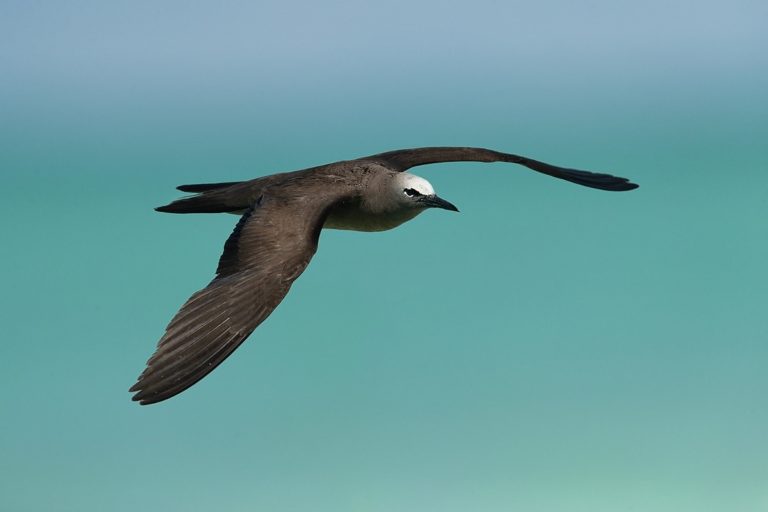
Brown Noddy, A. s. pileatus. (Michaelmas Cay, Queensland, Australia; January 2, 2020.) © J.J. Harrison
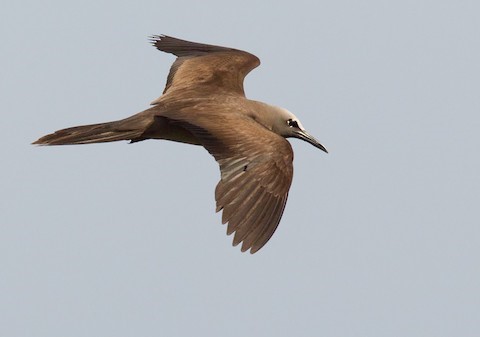
Brown Noddy, A. s. pileatus, appearing generally pale to medium-brown. (Tench Island, New Ireland, Papua New Guinea; July 13, 2014.) © Lars Petersson
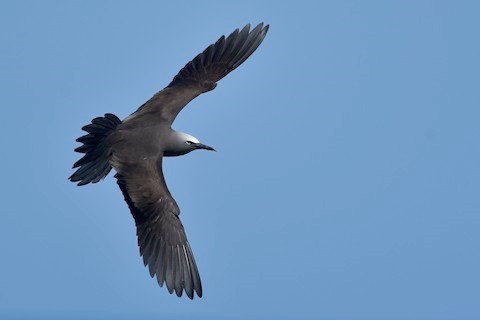
Brown Noddy, A. s. stolidus, appearing generally blackish-brown. (Dry Tortugas National Park; February 13, 2020.) © Daniel Irons

Brown Noddy, A. s. pileatus, showing contrasting pale-brown carpal bars. (Ogasawara Islands, Japan; May 28, 2017.) © Lars Petersson

Brown Noddy, A. s. ridgwayi—the most likely subspecies based on the location, but very dark and therefore possibly galapagensis, which is generally limited to the immediate vicinity of the Galápagos Islands. (Offshore from Tropic Star Lodge, Darién, Panama; June 12, 2017.) © William Hull
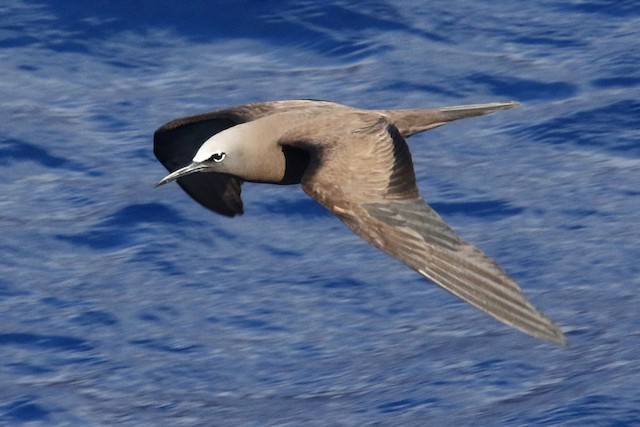
Brown Noddy, A. s. stolidus, showing contrast between warm brown wing coverts and blackish flight feathers. (Boatswain Bird Island, Ascension Island; April 5, 2018.) © Noah Strycker
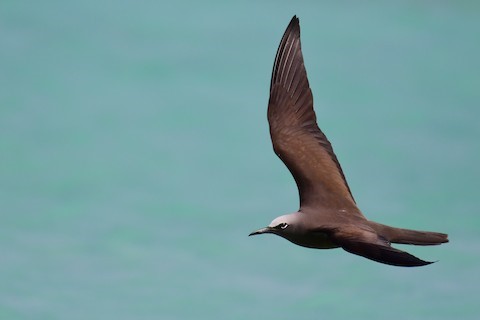
Brown Noddy, A. s. pileatus. (Michaelmas Cay, Queensland, Australia; August 22, 2019.) © Tristan Herwood

Brown Noddy, A. s. pileatus. (Michaelmas Cay, Queensland, Australia; March 1, 2016.) © Luke Seitz

Brown Noddy, A. s. pileatus, showing somewhat pale underwings and long, full tail. (Sofitel Marara Beach Resort, Bora Bora, French Polynesia; February 1, 2013.) © Daniel Jauvin

Brown Noddy, A. s. stolidus, showing pale underwings and long, full tail. (Arrecife Alacrán, Yucatán, Mexico; July 21, 2016.) © José Antonio Linage Espinosa
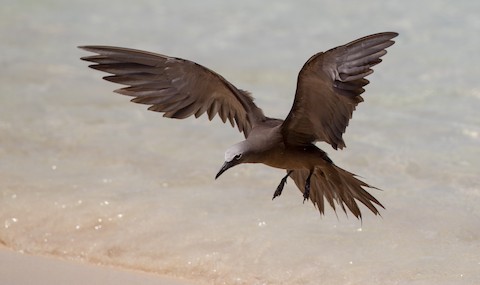
Brown Noddy, A. s. pileatus, showing somewhat pale underwings and long, full tail. (Michaelmas Cay, Queensland, Australia; December 2, 2017.) © Ian Davies

Brown Noddy, A. s. pileatus, showing mostly pale underwings. (Île aux Cocos, Rodrigues Island, Mauritius; October 20, 2013.) © Phillip Edwards
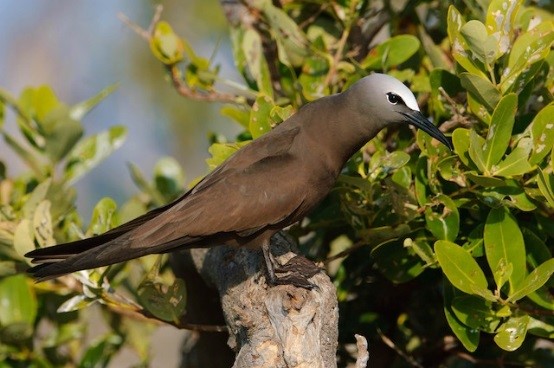
Brown Noddy, A. s. stolidus, appearing mostly warm-brown overall—also note unusually extensive whitish cast below the eye. (Bush Key, Dry Tortugas National Park, Florida; March 15, 2007.) © Gerrit Vyn
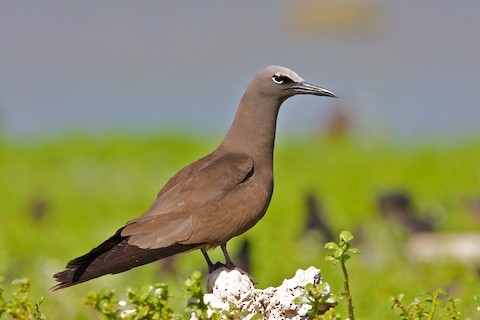
Brown Noddy, A. s. pileatus, appearing mostly warm-brown overall. (Naevo Island, Fiji; July 16, 2011.) © Michael Andersen
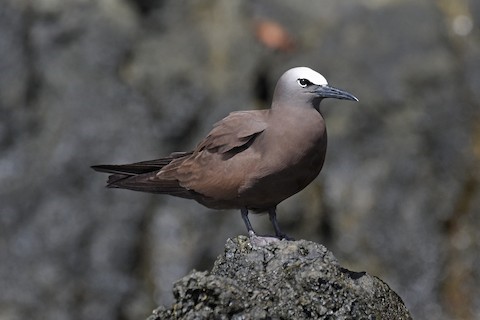
Brown Noddy, A. s. stolidus. (Little Tobago Island, Trinidad & Tobago; May 18, 2019.) © Janet Rathjen
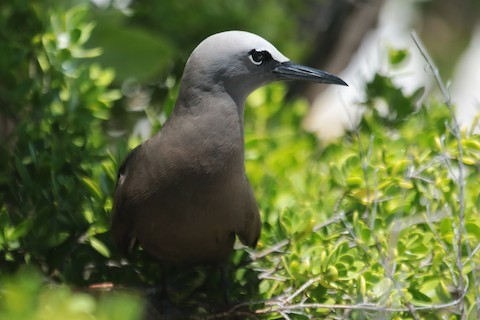
Brown Noddy, A. s. pileatus, with head and neck appearing whitish-gray nearly throughout. (Rangiroa, French Polynesia; November 3, 2013.) © Aaron Maizlish

Brown Noddy, A. s. ridgwayi. (Galera, Ecuador; February 24, 2016.) © Roger Ahlman
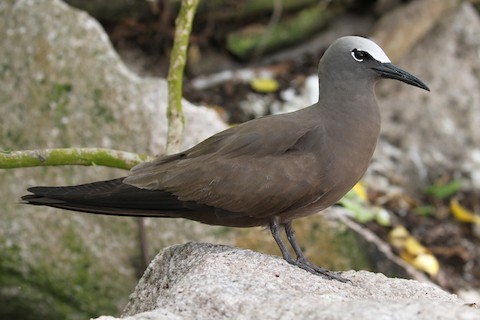
Brown Noddy, A. s. pileatus. (Aride, Seychelles; October 23, 2019.) © Oscar Campbell
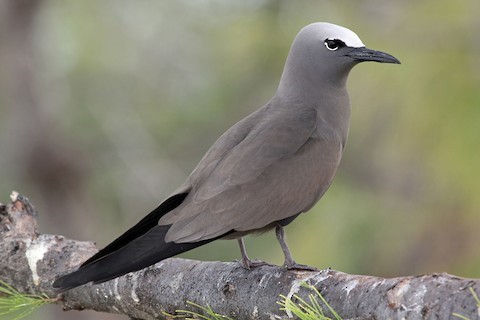
Brown Noddy, A. s. pileatus, appearing grayish-brown overall with contrastingly black flight feathers. (Île aux Cocos, Rodrigues Island, Mauritius; October 20, 2013.) © Phillip Edwards
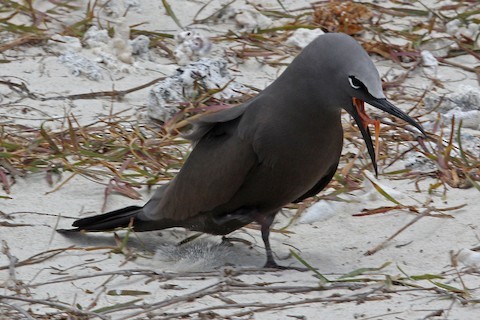
Brown Noddy, A. s. pileatus, with crown appearing mostly dark and showing apparent flexibility of upper mandible. (Île aux Cocos, Rodrigues Island, Mauritius; October 20, 2013.) © Phillip Edwards

Brown Noddy, A. s. pileatus, with nestling, appearing mostly warm-brown. (Michaelmas Cay, Queensland, Australia; January 17, 2020.) © Matthew Kwan
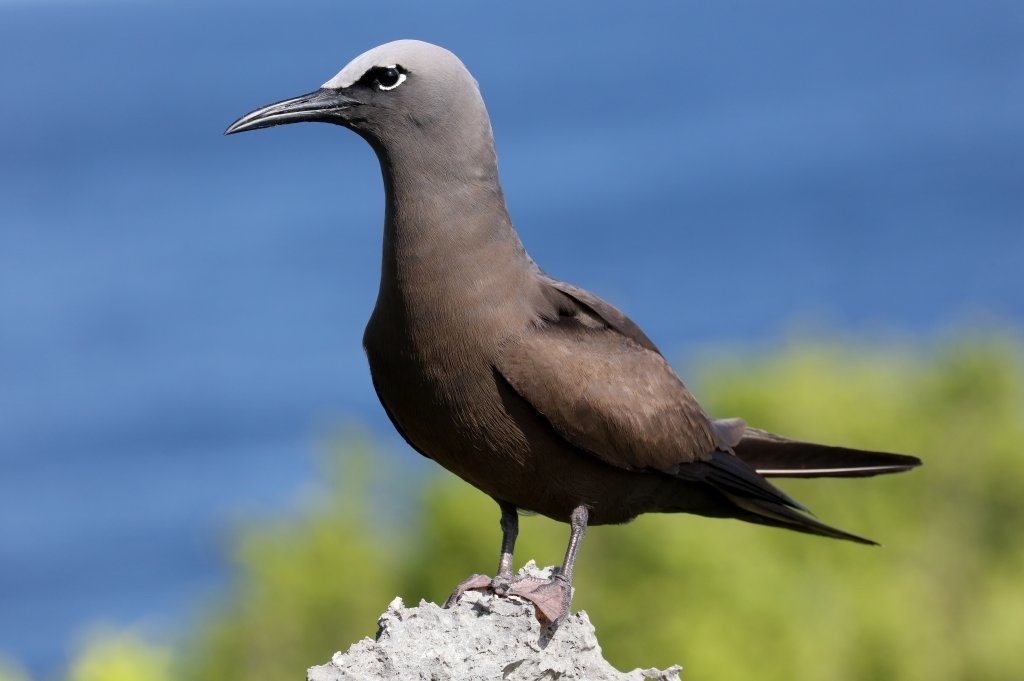
Brown Noddy, A. s. pileatus. (Christmas Island; August 31, 2017.) © Hickson Fergusson
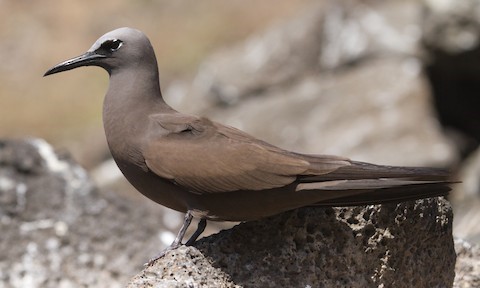
Brown Noddy, A. s. pileatus, appearing mostly warm-brown overall. (Nihoa, Hawaii; September 8, 2011.) © Eric VanderWerf

Brown Noddy, A. s. stolidus, appearing mostly warm-brown overall. (Fernando de Noronha, Brazil; March 31, 2017.) © Eduardo Augusto Ferreira
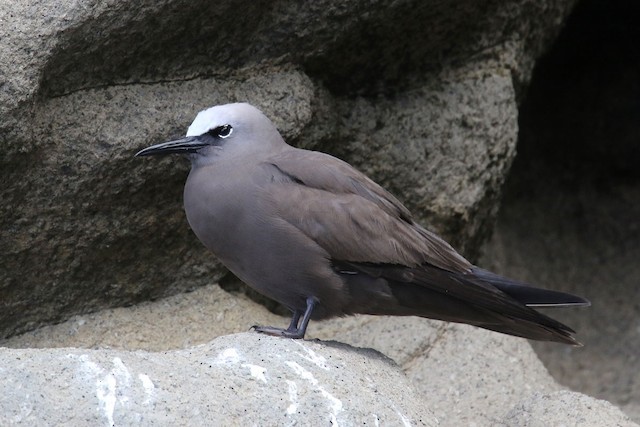
Brown Noddy, A. s. stolidus, appearing mostly grayish-brown overall. (Salt Beach, Tristan da Cunha; March 25, 2018.) © Noah Strycker
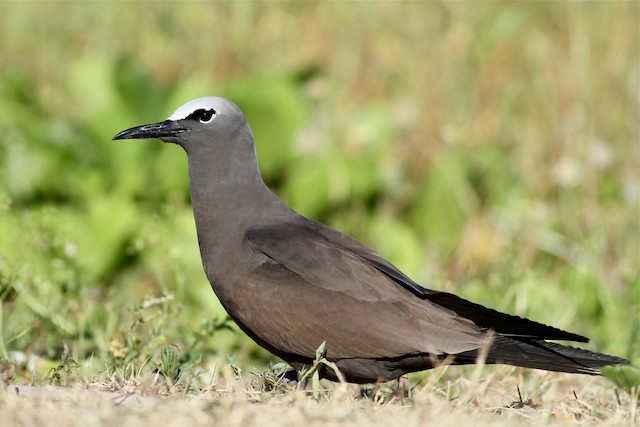
Brown Noddy, A. s. pileatus. (Lady Elliot Island, Queensland, Australia; November 15, 2014.) © Chris Wiley

Brown Noddy, A. s. pileatus, with bill appearing larger than usual in this posture. (Motu Tapu, Kiribati; August 18, 2019.) © Eric VanderWerf

Brown Noddy, A. s. pileatus, appearing mostly blackish-brown. (Michaelmas Cay, Queensland, Australia; September 5, 2015.) © Ray Turnbull
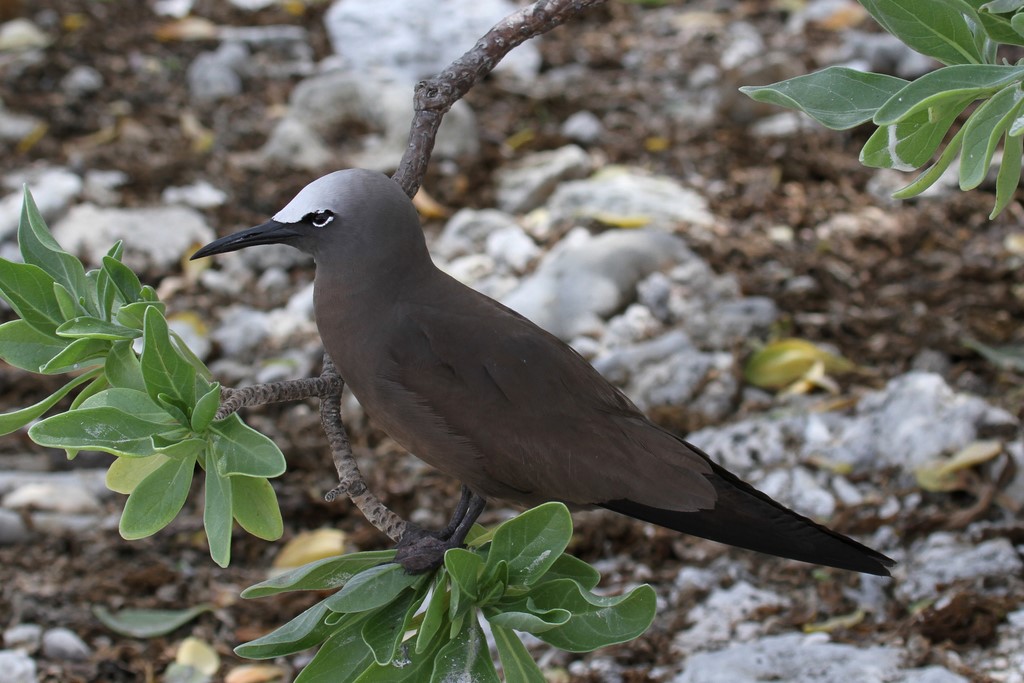
Brown Noddy, A. s. pileatus, appearing mostly blackish-brown. (Michaelmas Cay, Queensland, Australia; February 4, 2016.) © Margot Oorebeek
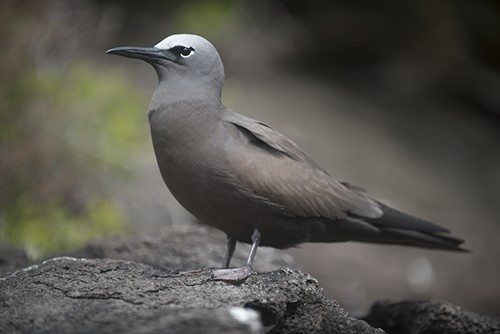
Brown Noddy, A. s. pileatus, appearing mostly cold-brown. (Lord Howe Island, Australia; January 19, 2017.) © Ian Hutton
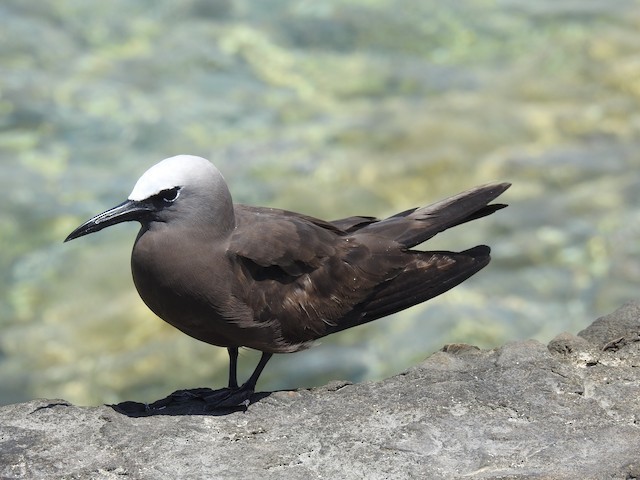
Brown Noddy, A. s. stolidus, appearing mostly blackish-brown and head extensively white. (Garden Key, Dry Tortugas National Park, Florida; May 6, 2018.) © Rangel Diaz
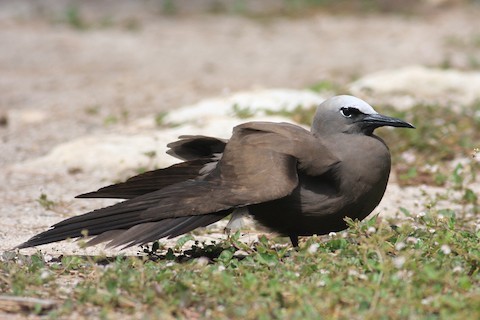
Brown Noddy, A. s. pileatus. (Aride, Seychelles; October 22, 2019.) © Oscar Campbell
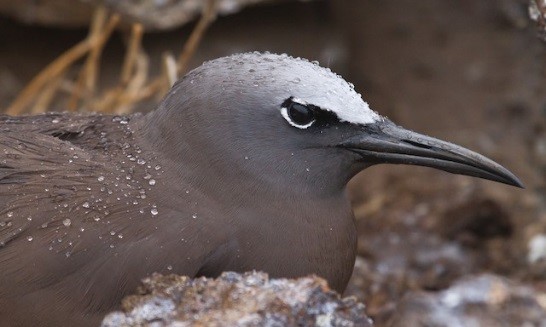
Brown Noddy, A. s. pileatus. (Nihoa, Hawaii; September 8, 2011.) © Eric VanderWerf
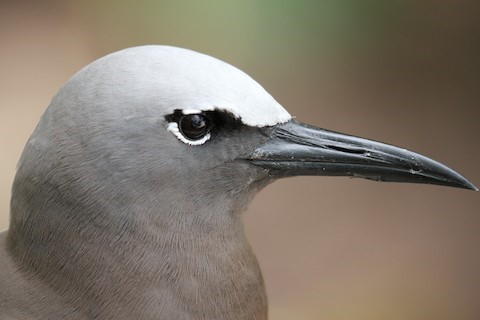
Brown Noddy, A. s. pileatus. (Aride, Seychelles; October 23, 2019.) © Oscar Campbell

Brown Noddy, A. s. pileatus, at nest. (Michaelmas Cay, Queensland, Australia; October 12, 2019.) © Nik Mulconray
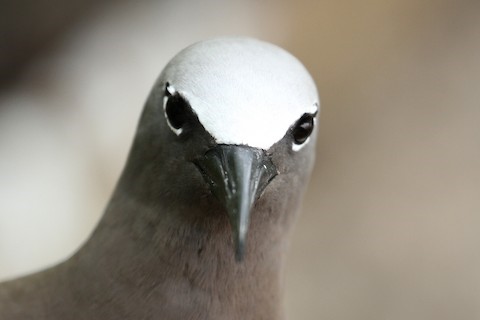
Brown Noddy, A. s. pileatus. (Aride, Seychelles; October 23, 2019.) © Oscar Campbell

Brown Noddy, A. s. pileatus, with head and neck appearing whitish-gray nearly throughout. (Aride, Seychelles; October 23, 2019.) © Oscar Campbell
“Galápagos Noddy.” The Galápagos subspecies galapagensis differs from the other subspecies—although these differences are inconsistent and internal variation within each subspecies limits their distinguishability.
Galapagensis is blacker on average, and most individuals have a slaty or ashy-gray cast on the body plumage.
Many individuals show only a limited whitish cap (adults may resemble typical immatures of the other subspecies).
Its wings tend to differ from the other subspecies in being more uniformly shaded above and darker underneath.

“Galápagos Noddy,” A. s. galapagensis. (Isla San Cristóbal, Galápagos, Ecuador; November 26, 2019.) © David M. Bell

“Galápagos Noddy,” A. s. galapagensis, showing mostly uniform coloration of upperwing—as is typical of galapagensis. (Tagus Cove, Isla Isabela, Galápagos, Ecuador; March 23, 2018.) © John Reynolds

“Galápagos Noddy,” A. s. galapagensis, appearing atypically pale. (Isla Rábida, Galápagos, Ecuador; March 24, 2018.) © John Reynolds
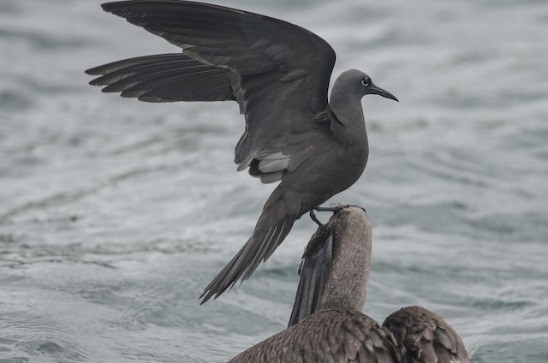
“Galápagos Noddy,” A. s. galapagensis, a sooty-brown individual perching on a juvenile pelican and showing dark underwing (typical of galapagensis) and long tail. (Ferry from Santa Cruz to Baltra, Galápagos, Ecuador; February 18, 2013.) © Nikolaj Mølgaard Thomsen
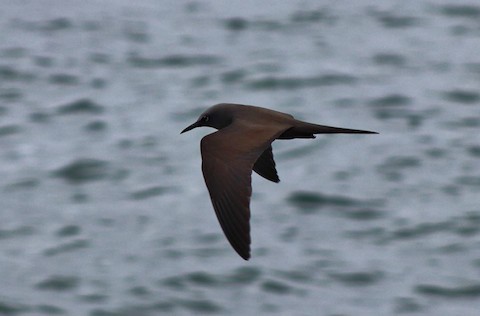
“Galápagos Noddy,” A. s. galapagensis, showing dark but warm shades of brown overall. (Isla Santa Cruz, Galápagos, Ecuador; January 15, 2015.) © Kevin Lester

“Galápagos Noddy,” A. s. galapagensis, a sooty-brown individual perching on a juvenile pelican. (Isla Santa Cruz, Galápagos, Ecuador; January 7, 2014.) © Nancy Cox
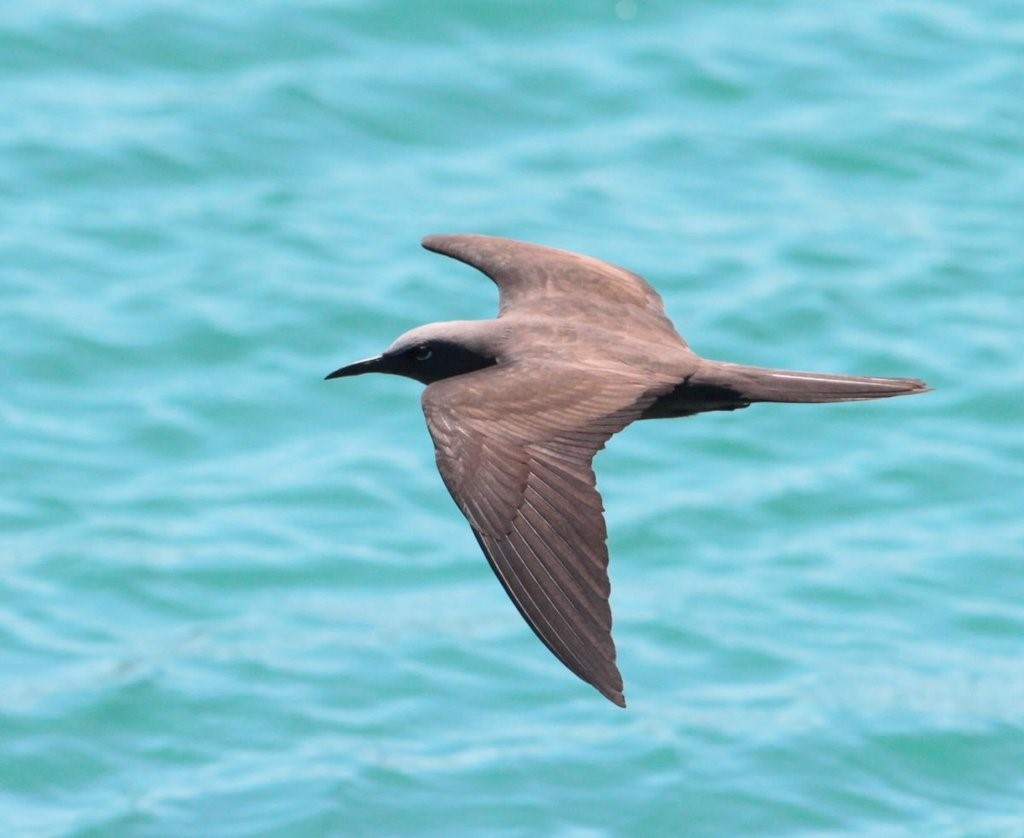
“Galápagos Noddy,” A. s. galapagensis, appearing atypically pale-brown. (Puerto Ayora, Isla Santa Cruz, Galápagos, Ecuador; November 27, 4) © Carmelo López Abad
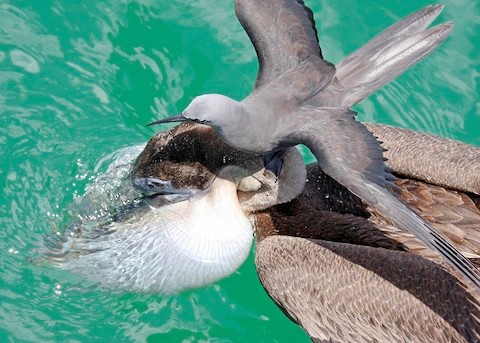
“Galápagos Noddy,” A. s. galapagensis, perching on a juvenile pelican and appearing pale-grayish-brown overall in this lighting. (Isla Baltra, Galápagos, Ecuador; September 23, 2009.) © Chris Charles
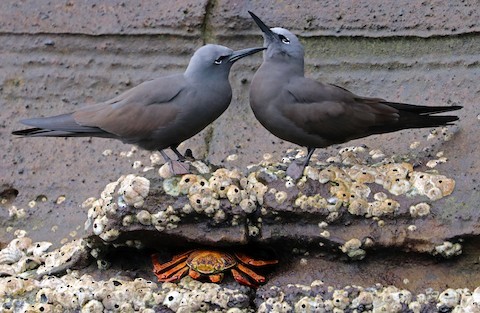
“Galápagos Noddy,” A. s. galapagensis, showing mixed slaty and warm dark-brown upperparts. (Punta Vicente Roca, Isla Isabela, Galápagos, Ecuador; December 25, 2019.) © Jason Wilder
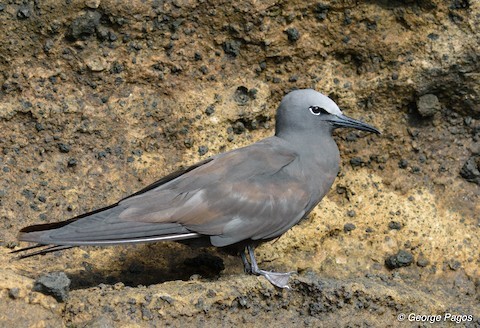
“Galápagos Noddy,” A. s. galapagensis, showing mixed slaty and warm dark-brown upperparts. (Punta Vicente Roca, Isla Isabela, Galápagos, Ecuador; July 12, 2015.) © George Pagos
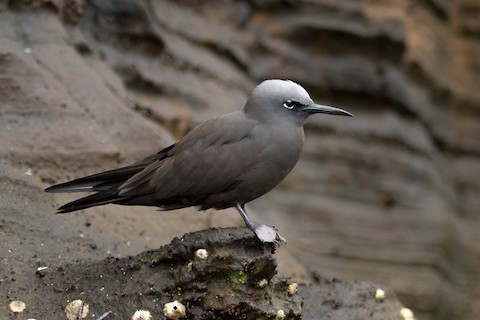
“Galápagos Noddy,” A. s. galapagensis, showing mixed slaty and warm dark-brown upperparts. (Punta Vicente Roca, Isla Isabela, Galápagos, Ecuador; July 25, 2018.) © David Marques

“Galápagos Noddy,” A. s. galapagensis, appearing mostly blackish-brown in this lighting. (Isla Champion, Isla Floreana, Galápagos, Ecuador; February 6, 2020.) © Tristan Jobin
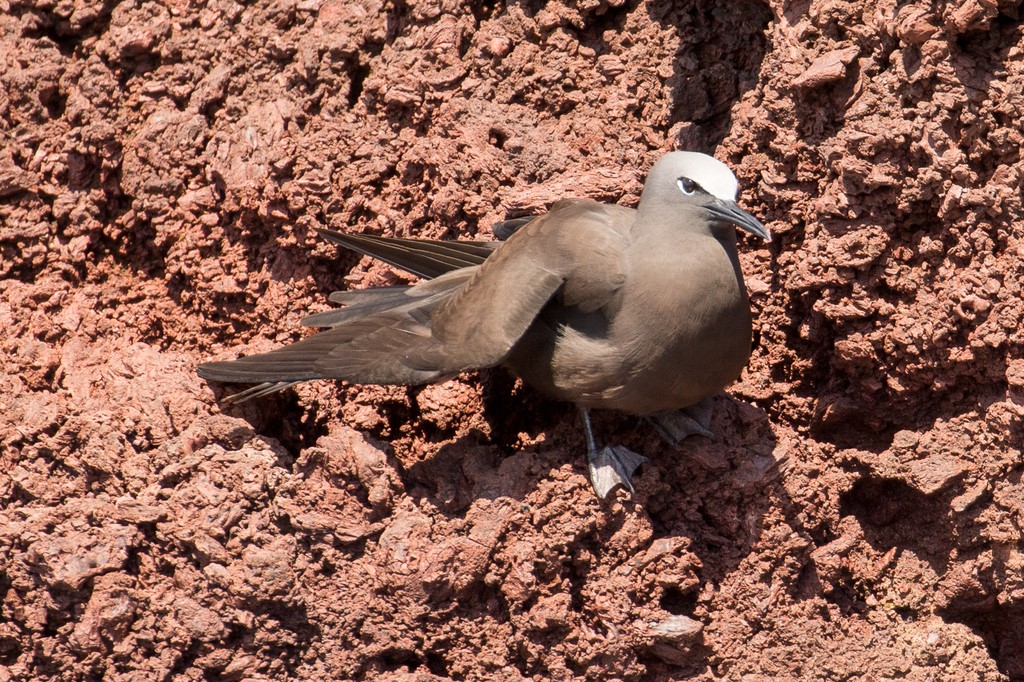
“Galápagos Noddy,” A. s. galapagensis, appearing mostly pale and warm-brown. (Isla Santa Cruz, Galápagos, Ecuador; March 24, 2018.) © John Reynolds
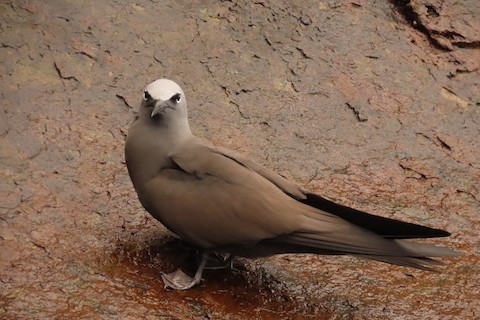
“Galápagos Noddy,” A. s. galapagensis, appearing mostly warm-brown. (Isla San Cristóbal, Galápagos, Ecuador; March 12, 2020.) © Carol Comeau
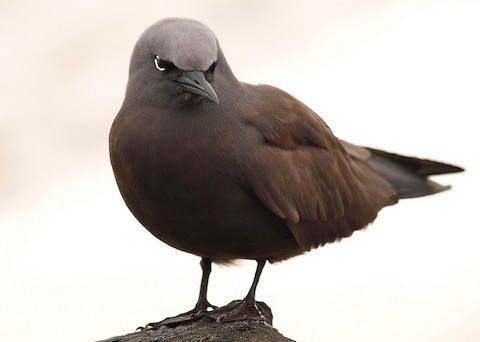
“Galápagos Noddy,” A. s. galapagensis, appearing mostly warm-brown with a comparatively dark crown. (Bahia Tortuga, Isla Santa Cruz, Galápagos, Ecuador; August 3, 2013.) © Jesus Barreda
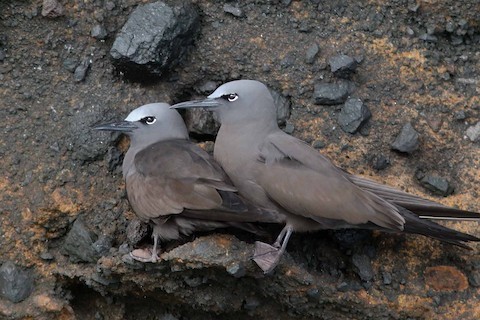
“Galápagos Noddy,” A. s. galapagensis, showing mixed slaty and warm dark-brown upperparts and largely pale-gray head and neck. (Punta Vicente Roca, Isla Isabela, Galápagos, Ecuador; June 26, 2017.) © Michael O’Brien
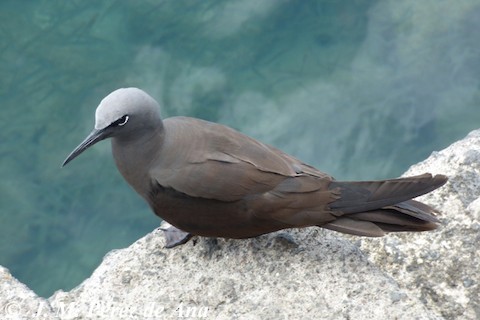
“Galápagos Noddy,” A. s. galapagensis, showing mixed slaty and warm dark-brown upperparts and largely pale-gray head and neck. (Isla Santa Cruz, Galápagos, Ecuador; July 18, 2019.) © Juan Manuel Pérez de Ana
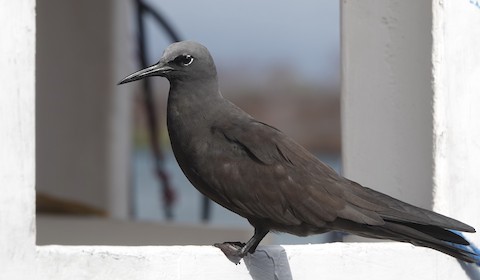
“Galápagos Noddy,” A. s. galapagensis, appearing mostly blackish-brown even in bright lighting. (Isla Santa Cruz, Galápagos, Ecuador; October 21, 2019.) © Peter Blancher
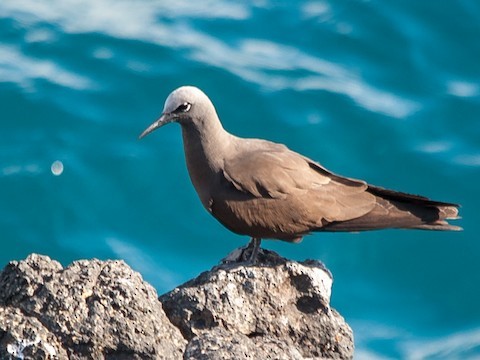
“Galápagos Noddy,” A. s. galapagensis, appearing mostly pale and warm-brown with a largely pale-gray head and neck. (Isla Baltra, Galápagos, Ecuador; May 5, 2010.) © William Stephens
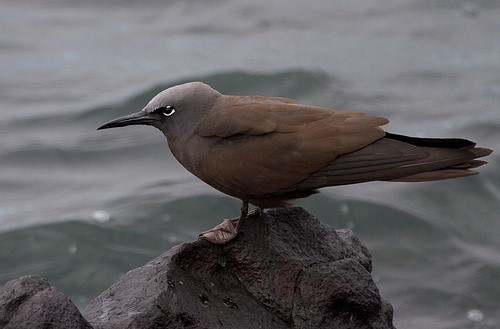
“Galápagos Noddy,” A. s. galapagensis, showing mixed slaty and warm dark-brown upperparts. (Isla Genovesa, Galápagos, Ecuador; August 9, 2010.) © John Crosby
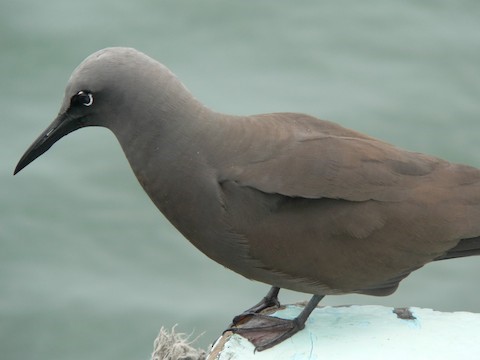
“Galápagos Noddy,” A. s. galapagensis, showing mostly dark-brown plumage with extensively grayish head and neck. (Academy Bay, Isla Santa Cruz, Galápagos, Ecuador; June 15, 2007.) © Alex Lin-Moore
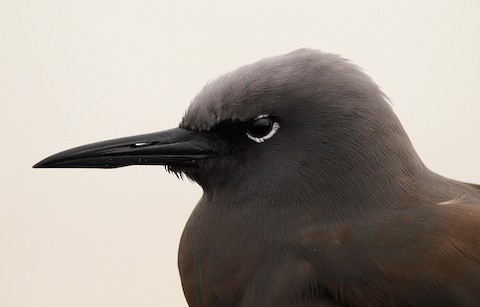
“Galápagos Noddy,” A. s. galapagensis, showing a comparatively dark crown. (Bahia Tortuga, Isla Santa Cruz, Galápagos, Ecuador; August 3, 2013.) © Jesus Barreda
Immature Plumages. Immatures resemble adults but darker—especially on the head, with white initially limited to the forehead and brow.
Juveniles begin uniformly dark-brown (in some cases, coal-black) except for a short white eyebrow.
First-cycle birds are mostly dark-brown, but often with pale-brown scaling on the wings and usually some white on the forehead. As they mature, the whitish portion of the crown extends farther back from the forehead.

Brown Noddy, A. s. pileatus, immature showing short white eyebrow. (Woolgoolga Headland, Coffs Harbour, New South Wales, Australia; March 22, 2008.) © Mat Gilfedder
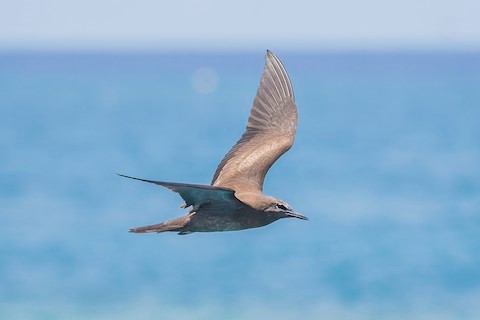
Brown Noddy, A. s. pileatus, juvenile with short bill, generally pale-brown plumage, and white speckling on the belly. (Michaelmas Cay, Queensland, Australia; January 17, 2020.) © Matthew Kwan

Brown Noddy, A. s. ridgwayi, immature. (Offshore from Cano Island, Costa Rica; December 17, 2015.) © Jeff Tingle
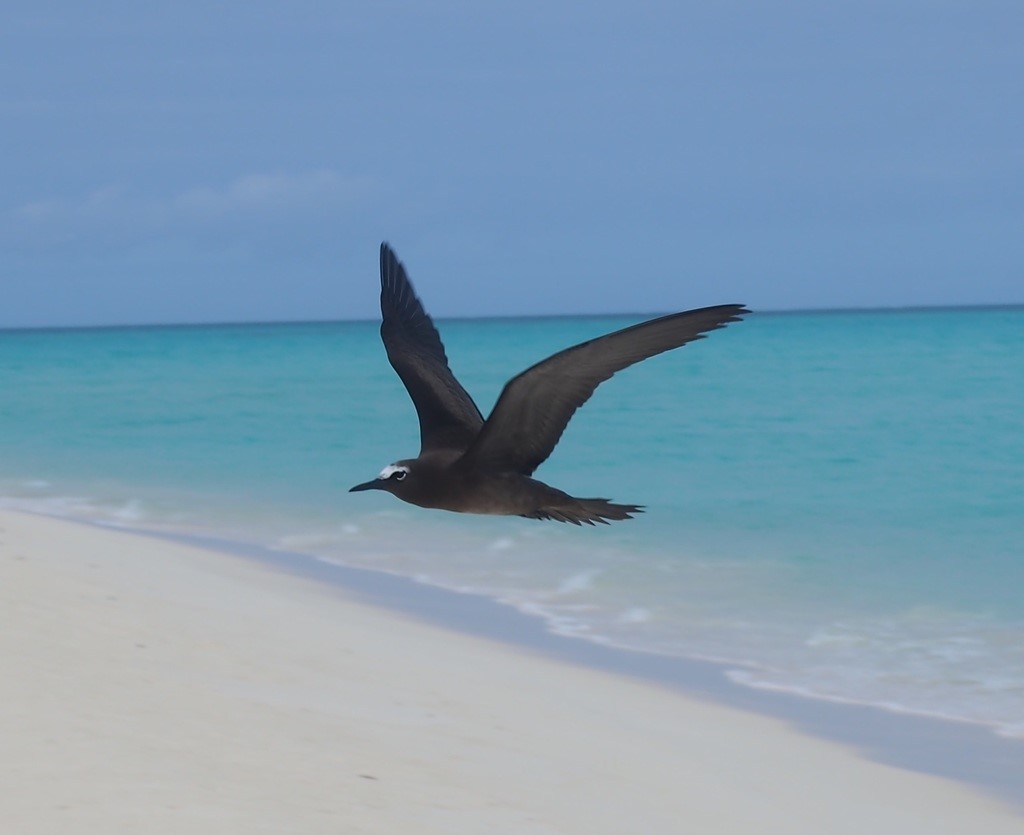
Brown Noddy, A. s. pileatus, immature with narrow white area on forehead. (Midway Atoll, Hawaii; September 16, 2017.) © sprosja93

Brown Noddy, A. s. pileatus, immature with dark-brown plumage, pale scaling on wings, and narrow white area on forehead. (Lady Elliot Island, Queensland, Australia; March 14, 2020.) © Barry Deacon

Brown Noddy, A. s. pileatus, immature with dark-brown plumage, pale scaling on wings, and extensively white forehead. (Sofitel Marara Beach Resort, Bora Bora, French Polynesia; January 31, 2013.) © Daniel Jauvin

Brown Noddy, A. s. pileatus, immature with warm-brown plumage, pale scaling on wings, and extensively white crown. (Kalinda, Wheeler Reef, Queensland, Australia; May 2, 2010.) © Richard Ling
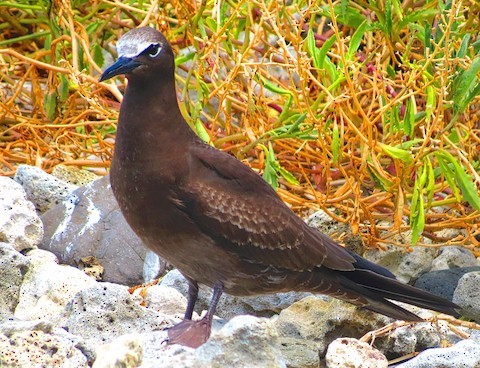
Brown Noddy, A. s. pileatus, immature with warm-brown plumage, pale feather-edges on wings, and extensively white crown. (Lord Howe Island, Australia; February 7, 2013.) © Donna Nagiello
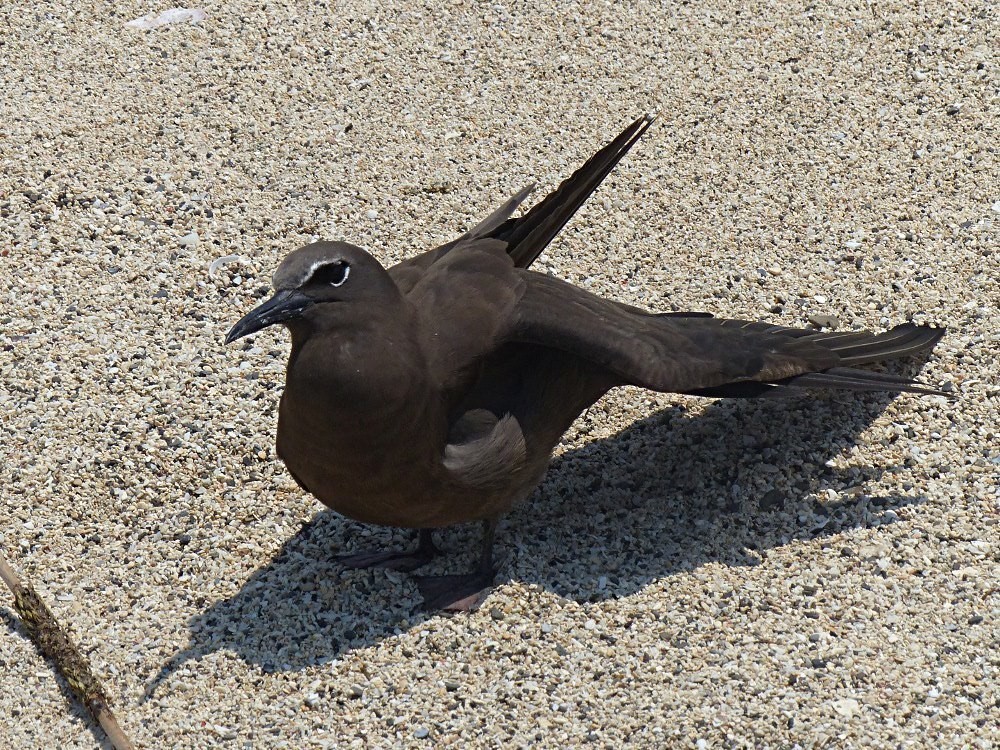
Brown Noddy, A. s. pileatus, juvenile with blackish plumage and short white eyebrow. (Lord Howe Island, Australia; November 21, 2019.) © John B

Brown Noddy, A. s. pileatus, immature with uniformly cold-brown plumage and shart white eyebrow. (Aride, Seychelles; October 23, 2019.) © Oscar Campbell
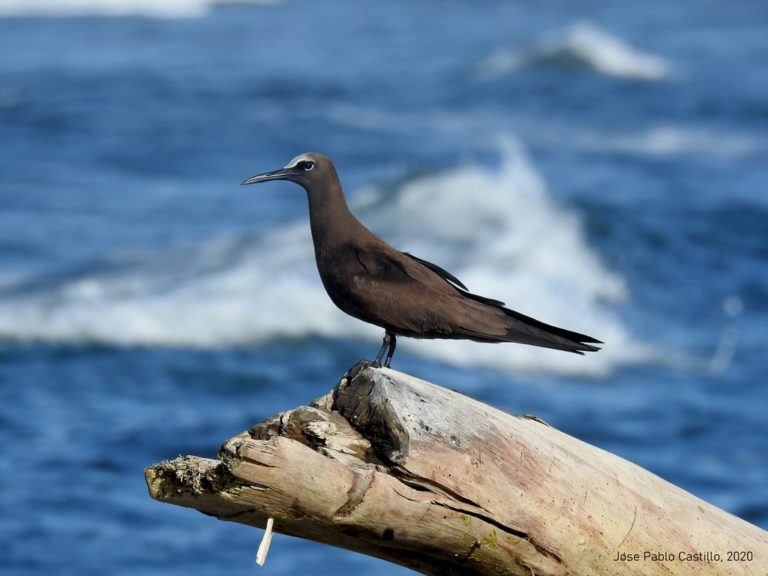
Brown Noddy, A. s. stolidus, immature with blackish plumage and narrow white area on forehead. (Heredia, San Rafael, Costa Rica; August 2, 2020.) © José Pablo Castillo
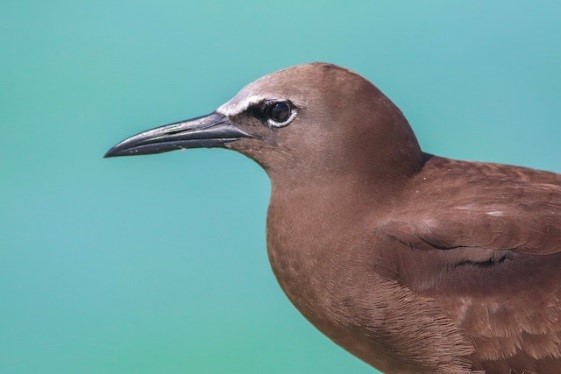
Brown Noddy, A. s. stolidus, immature with warm-brown plumage and narrow white area on forehead. (Garden Key, Dry Tortugas National Park, Florida; July 1, 2017.) © Thomas Ford-Hutchinson
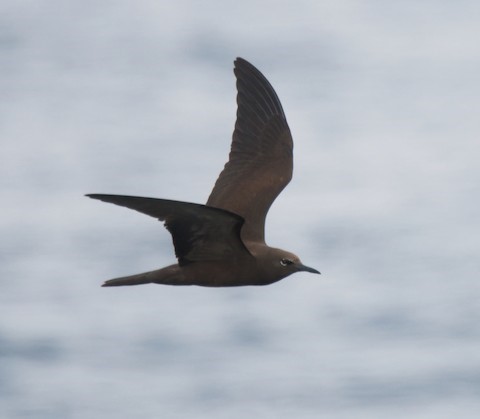
“Galápagos Noddy,” A. s. galapagensis, immature, appearing all dark-brown. (North Seymour, Galápagos, Ecuador; March 24, 2018.) © Forrest Rowland

“Galápagos Noddy,” A. s. galapagensis, immature, appearing all dark-brown. (Bahia Tortuga, Isla Santa Cruz, Galápagos, Ecuador; November 20, 2019.) © David M. Bell
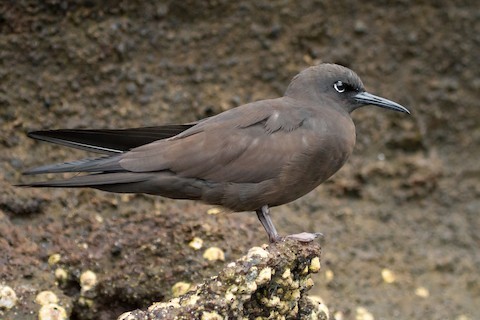
“Galápagos Noddy,” A. s. galapagensis, immature, appearing all dark-brown. (Punta Vicente Roca, Isla Isabela, Galápagos, Ecuador; July 25, 2018.) © David Marques

“Galápagos Noddy,” A. s. galapagensis, immature, appearing all dark-brown. (North Seymour, Galápagos, Ecuador; June 21, 2018.) © Leendert van Ginkel

“Galápagos Noddy,” A. s. galapagensis, immature, appearing all dark-brown. (Punta Vicente Roca, Isla Isabela, Galápagos, Ecuador; July 23, 2019.) © Michael O’Brien
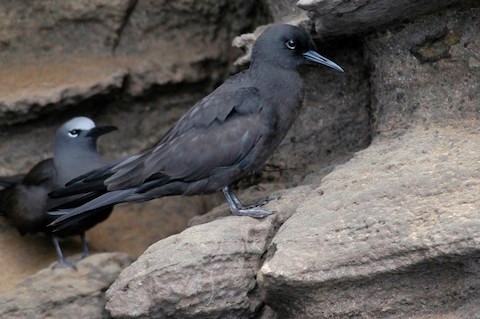
“Galápagos Noddy,” A. s. galapagensis, immature, appearing all blackish. (Isla Isabela, Galápagos, Ecuador; May 15, 2006.) © Marvin Hyett
Cf. Black Noddy. Brown Noddy is so widespread that it occurs essentially throughout the ranges of all other noddies. Most noddy identification consists of distinguishing Brown from the relevant member(s) of the Black Noddy complex.
In most cases, “Atlantic” and “Pacific Black Noddies” are uniformly blackish and have a smaller, more crisply demarcated white crown area than Brown Noddy. However, in worn plumage and harsh lighting Black Noddies can appear brown and their crowns can appear more diffuse. Brown Noddy’s crown coloration also varies somewhat with factors that include molt-stage and lighting. When general coloration and crown demarcation are inconclusive, there are potentially more objective differences in overall structure, bill size and shape, and wing contrast.
Structure: Black is somewhat smaller and more buoyant (tern-like) in flight. Conversely, Brown is bulkier and more gull-like. Although the proportions between their wing and tail measurements are similar, Brown’s average about 15% longer and, when seen in flight, its tail feathers often create the impression of being disproportionately long.
Bill Size and Shape: Black’s bill is appreciably thinner and straighter—or, in other words, Brown’s bill is thicker and more noticeably curved. Black’s bill averages longer while the rest of its head is smaller than Brown’s. In most postures, Black’s eye appears “off-centered”—closer to the back of its head than to the tip of its bill—whereas Brown’s eye is about equidistant from the back of its head and the tip of its bill.

“Atlantic Black Noddy,” A. m. atlanticus (foreground) with Brown Noddy, showing differences in size, general coloration, and demarcation of white crown—note that the Brown Noddy appears much larger in the frame even though it is farther from the camera. (São Pedro e São Paulo, Brazil; November 24, 2018.) © Ronald Santiago
Wing Contrast: Black’s wings are usually darker than Brown’s, and nearly uniform on the upperside, with little contrast between the coverts and flight feathers—whereas Brown’s wings typically appear two-toned: brown on the coverts versus darker, more blackish on the adjacent flight feathers.
(Note that the “Galápagos Noddy” is to some extent an exception to any generalizations about Brown Noddy plumage, but structural features differentiate it from Black Noddies.)
Cf. Lesser Noddy. Brown and Lesser Noddies occur together throughout much of the Indian Ocean. They are unlikely to be confused if seen clearly. Lesser differs in having more extensive white on the face—including the lores, so the white area surrounds the eye. Lesser also has the longest, thinnest bill of all the dark noddies, whereas Brown has shortest, thickest bill.
Notes
Polytypic species consisting of five recognized subspecies, one of which could be considered a distinct form: “Galápagos Noddy” (A. s. galapagensis).
Howell and Zufelt (2019) go so far as to recognize galapagensis as a separate species, but the evidence to support this separation seems insufficient. Galapagensis appears to average somewhat blacker and less distinctly white-capped than the other subspecies, but there is substantial variation within subspecies and overlap between them.
References
Alderfer, J., and J.L. Dunn. 2014. National Geographic Complete Birds of North America. National Geographic Society, Washington, D.C.
BirdLife International. 2018. Anous stolidus. The IUCN Red List of Threatened Species 2018: e.T22694794A132573846. https://dx.doi.org/10.2305/IUCN.UK.2018-2.RLTS.T22694794A132573846.en. (Accessed August 27, 2020.)
eBird. 2020. eBird: An online database of bird distribution and abundance. Cornell Lab of Ornithology, Ithaca, N.Y. http://www.ebird.org. (Accessed August 27, 2020.)
Gochfeld, M., J. Burger, G.M. Kirwan, and E.F.J. Garcia. 2018. Brown Noddy (Anous stolidus). In Handbook of the Birds of the World Alive (J. del Hoyo, A. Elliott, J. Sargatal, D.A. Christie, and E. de Juana, eds.). Lynx Edicions, Barcelona. https://www.hbw.com/node/54049. (Accessed May 18, 2018.)
Harrison, P. 1983. Seabirds: An Identification Guide. Houghton Mifflin, Boston.
Howell, S.N.G., and K. Zufelt. 2019. Oceanic Birds of the World. Princeton University Press.
Howell, S.N.G., and S.W. Webb. 1995. A Guide to the Birds of Mexico and Northern Central America. Oxford University Press, Oxford.
Lee, D.S., and W.A. Mackin. 2010. Brown Noddy. West Indian Breeding Seabird Atlas, http://www.wicbirds.net/brno.html. (Posted April 15, 2010. Accessed May 18, 2018.)
Pratt, H.D., P.L. Bruner, and D.G. Berrett. 1987. A Field Guide to the Birds of Hawaii and the Tropical Pacific. Princeton University Press.
Pyle, R.L., and P. Pyle. 2017. The Birds of the Hawaiian Islands: Occurrence, History, Distribution, and Status. Version 2 (January 1, 2017). http://hbs.bishopmuseum.org/birds/rlp-monograph/. B.P. Bishop Museum, Honolulu, Hawaii.
Raffaele, H., J. Wiley, O. Garrido, A. Keith, and J. Raffaele. 1998. A Guide to the Birds of the West Indies. Princeton University Press, Princeton, N.J.
